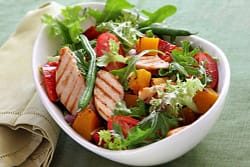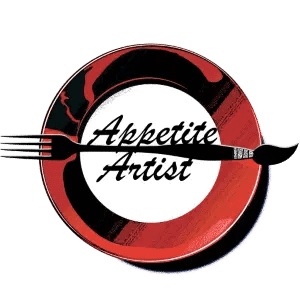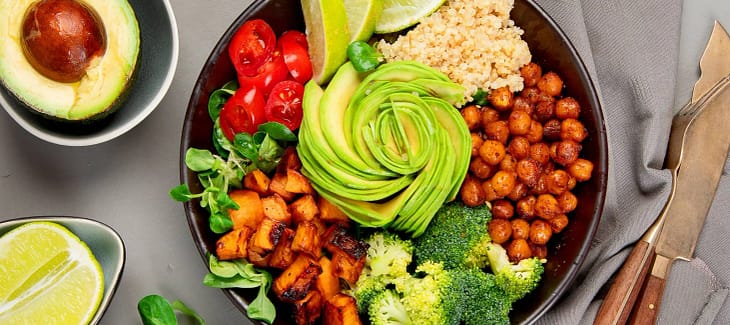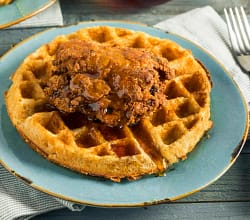When it comes to choosing a truly guilt-free breakfast food, you can’t get much better than a breakfast salad. You can make it right in your own home so that you have complete control over the ingredients you put in it. They are easily customizable, highly versatile, and contain healthy breakfast ingredients like fruit and eggs.
Breakfast salads (and overnight oats) are my go-to when I’m in a rush and need to whip up something fast. They aren’t that filling, however, but this issue can easily be remedied by pairing your salad with a hearty bowl of oats or avocado toast. We will go over exact ingredients and food pairings in more depth later on.
One advantage that breakfast salads have is that you can prep it a day in advance, and it will still taste great. It shares this advantage with overnight oats, making it perfect if you need to eat something fast. All you have to do is make your breakfast salad the night before your next morning and place it in the fridge. Make sure it’s covered in plastic wrap first, though.
What to put in your breakfast salad
You can put almost anything into a breakfast salad, as long as it’s not high in sugar or too liquidy. Most fruits, vegetables, nuts, beans, legumes, and seeds work great in a breakfast salad. You can even make a killer plant-based healthy salad that uses tofu, chickpeas, and lentils. Tofu scramble is a great replacement for egg scramble in any breakfast recipe if you are vegan.
In general, pan-fried vegetables like smoked cucumber, bell peppers, and caramelized onion work great as the base for your salad. You can add a layer of lettuce or spinach on top and drizzle the dish with some olive oil. You can finish off the salad topping by adding filling foods like hard-boiled eggs, feta cheese, and tuna salad. With the right ingredients, you can easily create a healthy breakfast salad that’s high in fiber and protein. It’s a killer meal that is quite easy to make!
To minimize any health risk of eating plant-based foods that are past their expiration date, I recommend buying frozen fruits and vegetables. This way, you can simply take out what you need and let them thaw out before eating.
Health Benefits of Eating Salads

When it comes to salads, they are often presented as a side dish to a main course like chicken breast or pizza. However, breakfast salads work best when you make it a full-course breakfast meal in a large, single-serving bowl. Any salad of this variety is fast and easy to make with just a few key ingredients. These key ingredients may include certain vegetables like lettuce and spinach, and protein-packed ingredients like chicken pieces or tofu scramble.
Common breakfast foods like hard-boiled eggs, French toast, breakfast sausage, and mixed fruit work great when cut into small pieces. You can pair your salad with a side of Greek yogurt or overnight oats if you want.
Breakfast salads are great for weight loss since they contain lots of nutrients, but not too many calories. Additionally, most fruits and vegetables you put in your salad are jam-packed with vitamins, minerals, insoluble fiber, and healthy sugars that keep your energy levels and mood high throughout the day.
Some salads lack enough protein to be considered a complete breakfast, but you can control your salad to change that. By adding high-protein foods like chicken strips, peanuts, feta cheese, quinoa, lentils, and eggs, you can make your breakfast salad a protein-packed power bowl.
List of Healthy Breakfast Salad Toppings
For some more inspiration, here are popular breakfast salad toppings and mix-ins.
Fruit-Strawberries, blueberries, sliced banana, chopped tomato, blackberries, raspberries, coconut shavings, pomegranate, pineapple, orange, mandarin, watermelon, cantaloupe, honeydew, avocado, kiwi, olives, peas, jalapeno.
Most fruits contain healthy sugars that positively affect metabolism when you consume them in the morning.
Vegetables-artichoke, broccoli, celery, brussels sprouts, chives, leeks, Bok choy, bell peppers, cucumbers, cauliflower, eggplant, kale, lettuce, butternut squash, spinach, radish, turnip, garlic cloves.
Vegetables are a must-have in your breakfast salad, as they contain most of the vitamins, minerals, and fiber you need to support your body throughout the day. As mentioned earlier, buying frozen veggies and thawing them when ready is a good idea to ensure your salad is fresh.
Nuts-chopped pecans, walnuts, almonds, cashews, peanuts.
I recommend keeping your nuts chopped so that they can blend in well with the salad.
Seeds-pumpkin, flax, sesame, sunflower, poppy, chia.
Herbs-Basil, parsley, oregano, dill, rosemary, cilantro, microgreens.
Spices-garlic, ginger, mint, cumin, onion, curry powder, black pepper, paprika, salt.
Don’t overdo it on the spices because they could interfere with the overall taste.
Dressings + Oils-olive oil, coconut oil, ranch dressing, thousand-island dressing, balsamic vinaigrette, blue cheese, French dressing, peanut sauce, honey mustard, tahini sauce.
Meat-Small chicken pieces, small steak pieces, bacon bits, tuna salad, chicken salad, salmon strips.
Meat is the easiest way to fill your salad with some extra protein.
Vegetarian/Vegan Protein Options-Tofu, black beans, peas, soybeans, chickpeas.
Other Toppings-Feta cheese, parmesan, shredded cheese, dark chocolate shavings, lemon juice, wonton strips, hard-boiled eggs cut up, lentils, quinoa, pilaf.
Ultimately, your best breakfast salad should contain ingredients that are high in fiber and protein.
Sample Breakfast Salad Recipe
Ready to create your own breakfast salad from scratch?
If you don’t know where to start, here is a perfect starting point! This sample breakfast salad recipe is easy to replicate and provides a good balance of protein, fiber, and vitamins. Pan-frying vegetables like peppers and cucumbers is a fun way to add extra flavor to your meal.
To pan-fry anything, you need a stove, a pan, vegetables, and a viable flavor-enhancing oil like coconut or olive oil. The cooked veggies will combine with the olive or coconut oil you used and will taste zesty and juicy. Be sure to mix the ingredients around and make sure the flavor spreads evenly throughout your salad. Once done, you can add various dressings and spices to not only ramp up the flavor even more but make it look aesthetically pleasing, too.

Breakfast Salad with Cooked Vegetables Tutorial
Equipment
- 1 wooden spoon
- 1 large bowl
- 1 boiling pot
- 1 large skillet
Ingredients
- ½ cup chopped cucumbers
- ¾ cup small cherry tomatoes
- ½ cup chopped spinach
- 1 cup bell peppers any variety of red/green/yellow
- Half an avocado, diced
- ⅛ cup mixed herbs any variety of basil, parsley, dill, etc
- 2-3 eggs for boiling
- ¼ cup toasted nuts pine nuts, cashews or peanuts
- ¼ cup tuna salad/chicken salad optional
- ½ tsp salt
- ½ tbsp olive oil
Instructions
- Fill a metal pot with water, and heat it up to a rolling boil on your stove.
- Add 2 or 3 eggs into your boiling water and let them cook for about 10 minutes. This will give you hard-boiled eggs.
- Take out a large skillet (preferably while your eggs are boiling) and place it on a separate part of your stove. Heat it up to about medium heat.
- Pour your ½ tbsp olive oil on the pan and let it soak around. Then, throw in your tomatoes, cucumbers, spinach, and bell peppers.
- Cover the pan with a lid so that the oil doesn’t sizzle out and burn you. Let the ingredients cook until the bottoms caramelize (blackened with a slightly charred exterior). This normally takes 2-5 minutes.
- Stir around and flip the vegetables with a wooden spoon. This will help to cook both sides of your vegetables evenly and soak up all the juicy oil. Cook for an additional 2 minutes.
- Once finished, let the vegetables and hard-boiled eggs cool off and place them in a bowl. Chop the hard-boiled eggs and veggies into bite-sized pieces. They don't have to be too small, just small enough to mix easily.
- Add the rest of the ingredients into your bowl and mix everything with your wooden spoon as best you can, so that all the ingredients will soak up the nice, juicy flavor.
- Enjoy with a glass of water or any side you prefer.
How To Store Your Salad For Later Use
Salads are easy to store in any fridge, simply by covering the top of your bowl in plastic wrap. However, do not store the salad for longer than a week, because the fruits/veggies in your salad will start to rot and spread to other ingredients. Also, a large amount of salt will draw moisture out of your salad, making it last not nearly as long.
Breakfast salad cannot be stored frozen.






